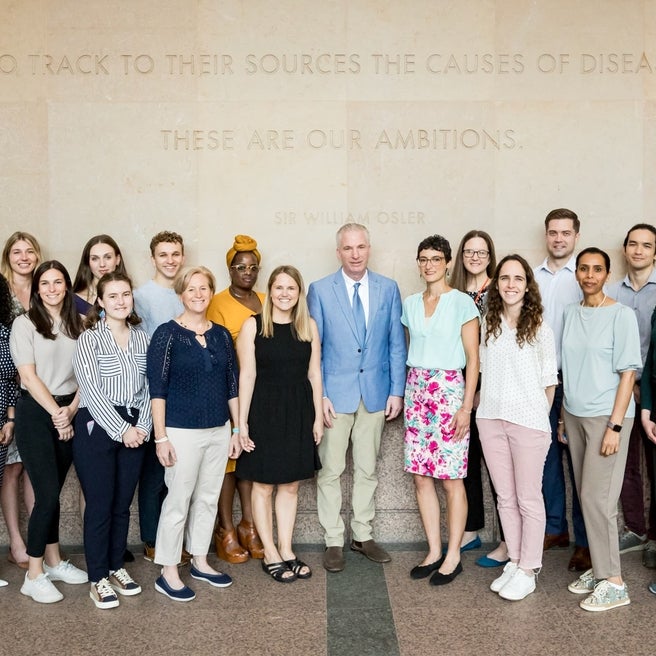What is 22q11.2 deletion?
22q11.2 deletion is a chromosomal difference that may or may not "run in the family" (meaning it's hereditary). The condition is present in approximately one out of every 2,000 to 4,000 live births, and in 5-8 percent of children born with cleft palate.
The 22q11.2 deletion is the underlying cause of the medical problems associated with DiGeorge syndrome, velocardiofacial syndrome and conotruncal anomaly face syndrome, as well as some of the problems associated with Opitz G/BBB and Cayler cardiofacial syndromes.
22q11.2 deletion is almost as common as Trisomy 21, also known as Down syndrome, which is a more widely recognized chromosomal disorder.
Children with 22q11.2 deletion and duplication syndromes often have other health problems, including:
- Heart defects
- Feeding difficulties
- Gastrointestinal problems
- Immune system problems
- Wounds that don’t heal properly
- Growth problems
- Delayed development in speaking, rolling over, sitting up or walking
- Cleft palate
- Low calcium levels
- Behavioral, emotional, and psychiatric differences that may cause ADHD, autism, anxiety and more
If your child has 22q11.2 deletion, they have a 50 percent chance of passing it on to their children.
Causes
Most cases of 22q 11.2 deletion and duplication syndromes occur at random and aren't inherited or related to any identifiable cause. However, approximately 5-10 percent of children with a 22q11.2 deletion inherit it from a parent who has a mild — usually undiagnosed — form of the disorder. Because the disorder is so variable, even people from the same family, with the same deletion, may have very different kinds of problems.
To understand how the 22q11.2 deletion occurs, you first need a basic understanding of what chromosomes are. Chromosomes, which are in every cell in our bodies, are made up of smaller structures — called genes — which are, in turn, made up of DNA.
Most people have 23 pairs of chromosomes (46 total), with one of each pair coming from their mother and the other from their father. Chromosomes are numbered 1 through 22; the 23rd pair are called sex chromosomes (X and Y) because they determine a person's gender — male (XY) or female (XX). Chromosomes are also divided into two parts called "arms." The top half is the short or "p" arm and the bottom half is called the long or "q" arm.
When a baby is conceived with either too much or too little genetic material, birth defects can occur. This may include a:
- Whole extra chromosome, such as with Down syndrome (an extra 21)
- Whole missing chromosome, such as with Turner syndrome (a missing X)
- Piece of extra or missing material
- Complex rearrangement of genetic material.
Since genes are the body's blueprint, when there are lost or extra genes, the blueprint changes. This frequently leads to birth problems and learning differences.
People with a 22q11.2 deletion have a very small piece of chromosome 22 missing; that's why the disorder is called a "deletion." The q11.2 tells everyone who works in genetics that the missing piece is in a very specific spot on the "q" arm — also called the "long" arm — of the chromosome.
Signs and symptoms
The medical problems associated with the 22q11.2 deletion vary widely. For example, one child with the disorder might have no heart problem, while another child with the same disorder might have a very mild or very severe heart defect.
Children with the 22q11.2 deletion and duplication syndromes often have problems that involve many different bodily systems. Many of the symptoms mimic other conditions so it is important to talk to your child’s doctor if you suspect your child and 22q11.2 deletion syndrome.
Some of the common symptoms are listed below.
Cardiovascular defects
- Tetralogy of Fallot
- Ventricular septal defect
- Atrial septal defect
- Interrupted aortic arch
- Truncus arteriosus
- Vascular ring
Feeding difficulties
- Nasal regurgitation (spitting up through the nose), which may happen because of a cleft palate
- Repeated bouts of spitting up or vomiting due to esophageal dysmotility
- Gastroesophageal reflux disease (GERD)
- Tracheoesophageal fistula
Gastrointestinal problems
- Mild to severe constipation
- Intestinal malrotation (twisting)
- Hirschsprung's disease
- Diaphragmatic hernia
- Inguinal and umbilical hernia
Immune system problems
- Recurring ear infections, especially when a child is very young
- Wound infections/wounds that won't heal properly
- Recurring respiratory infections
- Autoimmune diseases, such as juvenile rheumatoid arthritis, idiopathic thrombocytopenia and vitiligo
Growth problems
- Sometimes as a result of hormone growth deficiency
Delayed development
- Mild speech delays
- Delay in emergence of language
- Delayed motor skills development
Palatal anomalies
- Cleft lip and palate
- Cleft palate
- Velopharyngeal incompetence
Testing and diagnosis
Diagnosing 22q11.2 deletion can be difficult because the condition affects each child differently, can display different symptoms that often vary in severity, and can be associated with many other disorders. In fact, most parents consult a number of physicians before their child's problem is finally pinpointed.
If your child's physician or specialist suspects your child has a 22q11.2 deletion, they will be referred for testing to confirm the diagnosis.
At CHOP, diagnosing 22q11.2 deletion begins with a thorough medical and family history. Your child will be examined by a physician and a geneticist. The geneticist will analyze your child’s DNA to see if that small part of chromosome 22 is missing.
CHOP’s 22q and You Center pioneered a new test, FISH (fluorescence in situ hybridization) test — a highly accurate diagnostic blood test — to detect the 22q11.2 deletion.
The FISH test works like a lock and key. The person in the laboratory has the "key" that "lights up" (fluoresces) if it finds the matching "lock" in the chromosome. If the lock is missing from one of the chromosome 22s, only one chromosome will light up in the area in question (q11.2), confirming that your child is missing material on chromosome 22.
Treatments
Treatment for 22q11.2 deletion syndrome varies depending on your child’s symptoms.
Because your child’s genetic makeup can't be changed, doctors can't "cure" the 22q11.2 deletion. Once your child is diagnosed, doctors will usually recommend that your child undergo evaluation in the areas we know this chromosomal difference affects.
Once your child’s medical and developmental problems are pinpointed, doctors can help develop plans that will manage them and help your child live as healthy a life as possible.
If your child has been diagnosed with a 22q11.2 deletion, they may require evaluation and treatment in the following areas:
Cardiology
Even if your child doesn't have a known heart defect and the likelihood of finding a previously unrecognized problem is low, a cardiologist's evaluation is important. An evaluation usually includes a chest X-ray, an electrocardiogram and an echocardiogram. If a heart problem is discovered, the 22q and You Center will partner with experts in CHOP’s Cardiac Center to treat your child.
Child development and psychology
Children with a 22q11.2 deletion may have learning style differences and require some extra help in school. In addition, young children may have delays in their developmental milestones and might benefit from early intervention, such as physical, occupational and speech therapy. That's why it's important to take your child for developmental testing on a regular basis to determine if he's having any problems and to identify appropriate intervention if needed.
Cleft palate
If your child is born with a cleft palate, you should consult a plastic surgeon that specializes in cleft palate and velopharyngeal incompetence. At CHOP, we have a specialized Cleft Lip and Palate Program to correct this craniofacial anomaly.
Your child should also see a speech and language pathologist who can also assess your child’s speech, language and — if she's young — feeding. Some centers have specialized computer methods of objectively measuring speech to decide if intervention is necessary. Some teams also have growth specialists and dentists who monitor face, jaw and tooth growth.
Ear, nose and throat and audiology
This evaluation may be part of the cleft palate team evaluation. Children with a cleft palate often have trouble with ear infections and can benefit from seeing an ear, nose and throat (ENT) doctor — also called an otolaryngologist. In addition, an ENT can help children who have problems with "noisy" breathing as a result of their disorder.
Since some children with a 22q11.2 deletion may also have a hearing loss. You child may benefit from a hearing test (audiogram), as well. Treatments for ENT issues will vary depending on your child’s needs.
Endocrinology
Some children with a 22q11.2 have problems with low calcium when they're newborns and may need a calcium supplement. During this time, a cardiologist or pediatrician will manage your child’s low calcium problems. However, if the problem continues, your child may need to see an endocrinologist (hormone doctor).
In addition, some older children with 22q11.2 deletion have problems with growth (called short stature) and may require growth hormone therapy. An endocrinologist can prescribe the drug treatment and monitor your child’s progress.
Feeding/nutrition
Children with a 22q11.2 deletion often have feeding difficulties, especially when they're newborns. A pediatrician who specializes in feeding can help. Your child's healthcare provider will only recommend an evaluation if a problem already exists.
Genetics
The geneticist is the person who's most likely to have an overview of your child's diagnosis. The geneticist stays up-to-date with the latest research about the 22q11.2 deletion. That's why it's important to take your child for a yearly evaluation. The geneticist can answer your questions about your child’s general care, as well as the chances the disorder will occur in any other children you may have.
Immunology
Many newborns with a 22q11.2 deletion have problems with their immune systems. They may have trouble with infections or certain vaccines. Most children outgrow this problem by their first birthdays, but some will continue to have trouble into later childhood and adulthood.
In addition, some children develop autoimmune diseases related to their immune deficiency, such as juvenile rheumatoid arthritis, idiopathic thrombocytopenia, vitiligo and Graves’ disease. Your child with 22q should be evaluated by an immunologist at least once to determine if any immunology issues need to be addressed.
Neurology
Some children with a 22q11.2 deletion have a seizure disorder (unrelated to low calcium) or balance problems — which require a neurologist's services. Ask your child's healthcare team if an initial evaluation with a neurologist may be helpful.
Urology
Some children have kidney problems — even a missing kidney — which a renal ultrasound will detect. In addition, some children have urinary tract infections, urinary reflux, bedwetting or urinary frequency.
If your child is having these types of problems, he should see an urologist who is also a specialist in the chromosome 22q11.2 deletion.
Follow-up care
The 22q and You Center at Children’s Hospital of Philadelphia provides follow-up care for inpatients and outpatients, as well as genetic counseling.
Genetic services offer families who have experienced a birth problem (including the 22q11.2 deletion) valuable information, including:
- Information about the problem's cause
- Your chances of having another child with the same problem
- Information about prognosis
- Access to ongoing support and information resources
In addition, because an increasing number of children with this disorder are reaching adulthood and their reproductive years — with a 50 percent chance of passing the disorder on to their own children — CHOP has arranged for patients over the age of 18 to be evaluated by the Adult Genetics Department at the Hospital of the University of Pennsylvania.
Outlook
Most children with 22q11.2 deletion syndrome do well medically and contribute positively to their community. Ongoing monitoring is encouraged to address any issues related to 22q as they develop.
Resources to help
22q11.2 Deletion and Duplication Syndromes Resources
22q and You Center Resources
We have compiled resources – including websites, support groups and more – to help you feel more confident in the care you are providing your child.

